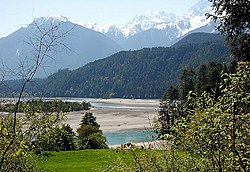Top Qs
Timeline
Chat
Perspective
Bomê County
County in Tibet, China From Wikipedia, the free encyclopedia
Remove ads
Pome County[3][4] (Tibetan: སྤོ་མེས་རྫོང)[2] or Bomê County (Chinese: 波密县)[2] is a county of Nyingchi Prefecture in the south-east of the Tibet Autonomous Region.[4] Historically known as Powo or Poyul, it was the seat of a quasi-independent kingdom until the early 20th century when troops of the Dalai Lama's Lhasa government integrated it into the central Tibetan realm. The population was 25,897 in 2004.[4]
Remove ads
Geography
The region of Powo or Poyul, which is now constituted as the Pome County, lies to the northeast of the Tsangpo gorge, where the Yarlung Tsangpo (Brahmaputra) river turns abruptly to the south on its course towards India.[5][6]
Two major rivers Yi'ong Tsangpo and Parlung Tsangpo flow into the Pome County from opposite directions to join near Tang-me. The combined river (called Yi'ong Tsangpo) exits the Pome County to the south to join Yarlung Tsangpo near Mount Gyala Peri.[4][7]
The lower reaches of these two rivers constitute Po-me or Lower Powo.[4]
Po-to or Upper Powo consists of the basin of another river Poto Tsangpo, which originates within the Pome County, along with its tributary Yarlung Chu. Poto Tsangpo joins Parlung Tsangpo to the west of the "Pome Town" (Tramog).[4]
Remove ads
History
Summarize
Perspective
The Kingdom of Powo, or sPo yul (“country of sPo”) was an offshoot of the ancient dynasty of the first Tibetan kings of the Yarlung Valley. Its inhabitants had a reputation as fearsome savages, which meant most travelers kept clear of it and so it was one of the least known areas in the Tibetan traditional feudal establishment.[8]
Its isolation was also enhanced by the belief by a great number of Tibetans that in its borders was one of the 'hidden lands' or beyul (Standard Tibetan: sbas-yul) referred to in the prophecies of Guru Rinpoche. Poba's area of control far exceeded the boundaries of Pome County. The kingdom acted as a protecting power for the streams of Tibetan pilgrims searching for this Promised Land in the East Himalayas from the Lopa tribes (Assam Himalayan tribes) from the mid-seventeenth century. Its power extended south over the Doshong La pass, to include the location of one of these earthly paradises called "Padma bkod" (written variously Pema köd, Pemakö and Pemako), literally 'Lotus Array', a region in the North-Eastern Province of Upper Siang of Arunachal Pradesh. Accounts of this terrestrial paradise influenced James Hilton's Shangri-La. A period of instability overtook the kingdom after Chinese incursions in 1905 and 1911.[9]
The Bomi region has predominantly been semi-autonomous since the Tubo era. During the Qing Dynasty, governance was effectively under the authority of the King of Bomi. In 1910, the last Qing amban Lian Yu, dispatched forces to eradicate the Bomê soil king. In 1911, nine counties were established in Bomê In 1928, the Kashag government dispatched forces to evict the son-in-law of the Bomê soil monarch, resulting in the complete integration of the Bomê region into Tibet.[10] By 1931 the Lhasa government had expelled the last Ka gnam sde pa ('king') and established two garrisons.[11]
In 1951, the People's Republic of China established the Second office in Chamdo, and in 1960, the three dzongs of Dzongdor, Boqu, and Yigong were consolidated and restructured into Bomê County.[12]
Remove ads
Climate
Summarize
Perspective
Pome has a monsoon-influenced oceanic climate (Köppen climate classification Cwb). The average annual temperature in Pome is 9.0 °C (48.2 °F). The average annual rainfall is 890.9 mm (35.07 in) with June as the wettest month. The temperatures are highest on average in July, at around 16.9 °C (62.4 °F), and lowest in January, at around 0.7 °C (33.3 °F).
Remove ads
Administrative divisions
Bomê County contains 3 towns and 7 townships.
Remove ads
Transport
Tourism
References
Bibliography
External links
Wikiwand - on
Seamless Wikipedia browsing. On steroids.
Remove ads





